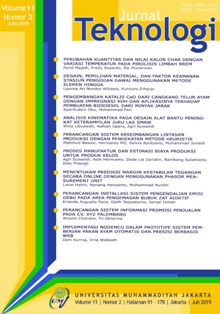PENGEMBANGAN KATALIS CaO DARI CANGKANG TELUR AYAM DENGAN IMPREGNASI KOH DAN APLIKASINYA TERHADAP PEMBUATAN BIODIESEL DARI MINYAK JARAK
Main Article Content
Abstract
Downloads
Article Details
COPYRIGHT POLICY
The author(s) of an article published in the Jurnal Teknologi retains ownership of the intellectual property rights in work (s).
PUBLISHING RIGHTS
The author(s) of an article published in the Jurnal Teknologi have unrestricted publication rights. The authors give the Jurnal Teknologi the right to publish the article and designate the Faculty of Engineering Universitas Muhammadiyah Jakarta Publishing as the original publisher of the article.
LICENSING POLICY
Journal of Mechanical Engineering and Sciences is an open-access journal that follows the Creative Commons Non-Commercial 4.0 International License (CC BY-NC 4.0), which states that:

Under this license, the reusers must give appropriate credit, provide a link to the license, and indicate if changes were made. Users may do so in any reasonable manner, but not in any way that suggests the licensor endorses users or their use.
Please take the time to read the whole license agreement (https://creativecommons.org/licenses/by-nc/4.0/). As long as reusers follow the license conditions, the owner cannot withdraw these freedoms. The following components are included under this license:
 Attribution: Users must provide appropriate attribution, including a link to the license, and indicate whether or not they made any modifications. Users are free to do so reasonably, but not in a manner that indicates the licensee approves of their usage.
Attribution: Users must provide appropriate attribution, including a link to the license, and indicate whether or not they made any modifications. Users are free to do so reasonably, but not in a manner that indicates the licensee approves of their usage.
 NonCommercial: Users may not use the material for commercial purposes.
NonCommercial: Users may not use the material for commercial purposes.
References
Badan Standardisasi Nasional. (2015). Biodiesel. SNI 7182:2015. Jakarta: Badan Standardisasi Nasional.
Buchori, L., Istadi, I., Purwanto, P., Marpaung, L.C., & Safitri, R.L. (2017) Roles of K2O on the CaO-ZnO Catalyst and its Influence on Catalyst Basicity for Biodiesel Production. Indonesia: Diponegoro University
Blasi C. D., Galgano A., & Branca A (2008). Effects of potassium hidroxide impregnation on wood pyrolysis. Italy: Napoli.
Cavallaro, S, J. C. J. Bart, N. Palmeri. (2010). Biodiesel Science and Technology From Soil To Oil. Woodhead Publising Series in Energy: No 7.
Huaping, Z. et al. (2006). Preparation of Biodiesel Catalyzed by Solid Super Base of Calcium Oxide and Its Refining Prosess.Chinese Journal of Catalysis, 2006, 27(5):391-396.
Fanny, W.A., Subagjo, Prakoso, T. (2012). Pengembangan Katalis Kalsium Oksida Untuk Sintesis Biodiesel. Jurnal Teknik Kimia Indonesia, Vol. 11, No. 2, 2012, 66-73.
Kesic, Z., Lukic, I., Zdujic, M., Mojovic, L. and Skala, D., 2016, Calcium Oxide Based Catalysts For Biodiesel Production : A Review, Chem Ing Chem Eng Q., 22 (4) : 391-408.
Ketaren, S. (2005). Teknologi Minyak dan Lemak Pangan. Universitas Indonesia. Jakarta.
Kouzu, M., Kasuno, T., Tajika, M., Sugimoto, Y., Yamanaka, S., Hidaka, J. (2008). Calcium Oxide As a Solid Base Catalyst For Transesterification of Soybean Oil and Its Application to Biodiesel Production. Fuel Processing Technology, 87, 2798-2806
Koswara, S. 2009. Teknologi Pengolahan Telur ( Teori dan Praktek). eBook Pangan.com
Mahreni dan Sulistyawati. 2011. Pemanfaatan Kulit Telur Sebagai Katalis Biodiesel Dari Minyak Sawit dan Metanol. Jurnal Teknik Kimia Indonesia.
Padil, Wahyuningsih, S., Awaluddin, A. (2010). Pembuatan Biodiesel dari Minyak Kelapa Melalui Reaksi Metanolisis Menggunakan Katalis CaCO3 yang Dipijarkan. Jurnal Natur Indonesia, 13(1), 27-23
Ristianingsih, Y., Hidayah, N., Sari, F.W. (2015). Pembuatan Biodiesel Dari Crued Palm Oil (CPO) Sebagai Bahan Bakar Alternatif Melalui Proses Transesterifikasi Langsung. Jurnal Teknologi Agro-Industri Vol.2 No.1
Rubiyanto, D. (2017). Metode Kromatografi: Prinsip Dasar, Praktikum & Pendekatan Pembelajaran Kromatografi. Yogyakarta.
Santoso, H., Kristianto, I., Setyadi, A. (2013). Pembuatan Biodiesel Menggunakan Katalis Basa Heterogen Berbahan Dasar Kulit Telur. Lembaga Penelitian dan Pengabdian kepada Masyarakat Universitas Katolik Prahayangan
Stadelman, E.J. (2000). Eggs and Egg Products. Francis, F.J (Ed): Encyclopedia of Food Science and Technology, second ed, John Wile, New York, pp. 593 – 599. December 3, 2015.
Yuwanta, T. (2010). Telur dan Kualitas Telur. Yogyakarta : UGM-Press.
Lingmei Yang, Pengmei Lv, Zhenhong Yuan, Wen Luo, Huiwen Li, Zhongming Wang and Changlin Miao (2012). Synthesis of biodiesel by different carriers supported KOH catalyst. Advanced Materials Research, ISSN: 1662-8985, Vols. 581-582, pp 197-201
Sharma, Y.C., Singh, B. 2011. Development of Biodiesel: Current Scenario. Renewable and Sustainable Energy Reviews. Vol.582. pp. 1-6.
Tehubijuluw, H., Sutapa, I.W., Lethulur, M. (2014). Waste Cooking Oil Conversion To Biodiesel Catalized By Egg Shell Of Purebred Chicken With Ethanol As A Solvent.
Wei, Z. Xu, C. and Li, B. (2009).Application of Waste Eggshell as Low-Cost Solid Catalyst for Biodiesel Production. Bioresorce Technology, 100(11), 2883-2885.
Wendi, Cuaca, V., Taslim. (2015). Pengaruh Suhu Reaksi dan Jumlah Katalis Pada Pembuatan Biodiesel dari Limbah Lemak Sapi dengan Menggunakan Katalis Heterogen CaO dari Kulit Telur Ayam. Jurnal Teknik Kimia USU, Vol. 4, No. 1
Wirakusumah, E.S. (2005). Menikmati Telur Bergizi, Lezat, & Ekonomis. Jakarta: PT Gramedia Pustaka Utama. 10 Desember 2015
Yan, S., O. Steven, Salley dan K.Y. Simon. 2009. “Simultaneous Transesterification and Esterification of Unrefined or Waste Oils Over ZnO-La2O3 Catalysts”. Applied Catalysis A : General. 353:203 – 212.

